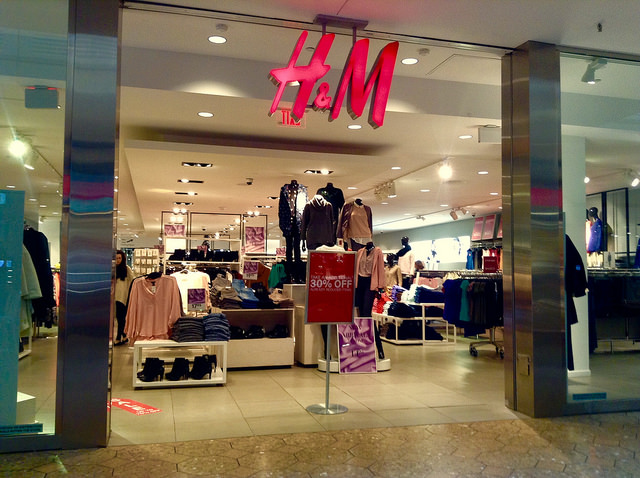
Roughly 98 percent of clothing sold in the U.S. is now made overseas.
That John Oliver — he really is a man after our own heart.
First, the Last Week Tonight host took on the great need to invest in our nation’s infrastructure. Now, Oliver is tackling another big problem that impacts American manufacturing — the continued dominance of inexpensive, foreign-made clothing.
In a segment that premiered on Sunday, Oliver looks at how “fast fashion retailers” like H&M and Zara are able to replenish their racks daily with the latest wares. He also lampoons traditional retailers such as the Gap that also sell cheap clothes that are almost always made overseas.
Look, I’ll be honest — I have quite a few items in my own closet from some of the retailers Oliver lampoons in the segment. And I bet you do, too. It can be hard to find affordable, American-made clothing. As the segment notes, just 2 percent of clothing sold in the United States is made in the United States.
"Sweatshops aren’t one of those '90s problems we got rid of, like Donnie Wahlberg, but one of those '90s problems we’re still very much dealing with, like Mark Wahlberg." John Oliver
It’s a dramatic shift. As recently as the 1990s, half of the clothes sold in the U.S. were made here.
“We produce clothes almost entirely overseas, where it’s much cheaper,” Oliver says. “And if 98 percent of your products could be made abroad, you should really start changing your name to reflect that fact. So, American Eagle [Outfitters] should become Bangladeshi Swamphen and Banana Republic should really become, actually that one is fine.”
All jokes aside, you probably already know why fashion has become a mostly foreign operation: Workers are paid shockingly low wages under terrible, unsafe conditions.
In the segment, Oliver outlines a series of labor violations in multiple countries from companies such as Gap and Walmart, and highlights the tragic Rana Plaza building collapse in Bangladesh that killed 1,100 garment industry workers.
“I know you think you’ve heard this story before, because you have. If you remember in the 1990s, sweatshops were a key point of outrage. Companies like Gap and Nike were protested, and most famously, there was this,” Oliver says, cutting to a clip highlighting the '90s-era controversy over Kathie Lee Gifford’s child-sweatshop-made clothing line. “The outcry over sweatshops wasn’t just loud, it got some results. Kathie Lee even testified in front of Congress.”
But the problem has only worsened. “Sweatshops aren’t one of those '90s problems we got rid of, like Donnie Wahlberg, but one of those '90s problems we’re still very much dealing with, like Mark Wahlberg,” Oliver quipped.
O.K., so there’s no question there’s a problem. But what can you and I actually do about it?
First things first — we can buy American-made clothing (and other products) whenever we have the opportunity. Buying American-made goods really does make a difference. If every American committed to buying just $64 worth of USA-made stuff each year, 200,000 new jobs would be created. It also supports companies that are trying to do the right thing.
While I have foreign-made clothes in my closet, I’ve also made a serious effort to buy Made in America garments whenever I can. My comfortable (and very trendy) black American Giant hoodie is one of my favorite pieces.
Here’s just a handful of other American-made brands to check out (and this is by no means a comprehensive list):
- WUUL: Standing for Workers United Union Labor, this California-based knitted head ware company sells American-made beanies.
- cinda b: TV host Cinda Boomershine started her handbag, totes and travel bags business because she couldn’t find a travel bag that fit her needs. These Indiana-made handbags are an American-made alternative to Vera Bradley, which has unfortunately shipped many of its jobs overseas in recent years.
- Mother Freedom: You are the father — of American-made clothes. Daytime legend Maury Povich is among the investors of this small Massachusetts outerwear manufacturer.
- Jolie & Elizabeth: The owners of this New Orleans-based company made a “pretty promise” to make their entire line of party dresses and formal ware in the United States.
- New Balance: Think you can’t find an American-made athletic shoe? Think again. New Balance makes more than 4 million pairs of shoes in the United States each year.
- Nanette Lepore: The designer has set herself apart by remaining committed to making most of her high-end line in New York’s Garment District, and she recently began crafting some of her shoe collection in Los Angeles.
You can also check out our 2014 Holiday Gift Guide for more American-made clothing ideas.
Along with taking a stand with your wallet, you can raise your voice to support a National Manufacturing Strategy, which will help revitalize the manufacturing sector and support those companies that are working hard to Keep it Made in America.
The surge in foreign-made clothes isn’t going to go away overnight. But more American-made garment companies are launching nationwide, and it’s up to us to help them succeed.
Do you have a favorite Made in America clothing company? Send me a line at elizabethbb@aamfg.org and we’ll look into profiling it for the blog.
